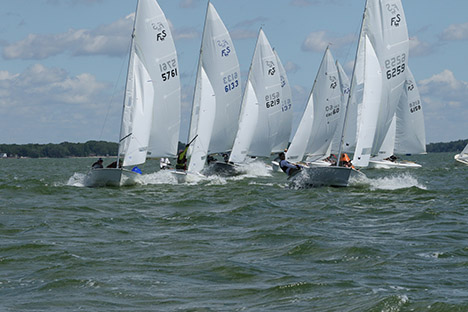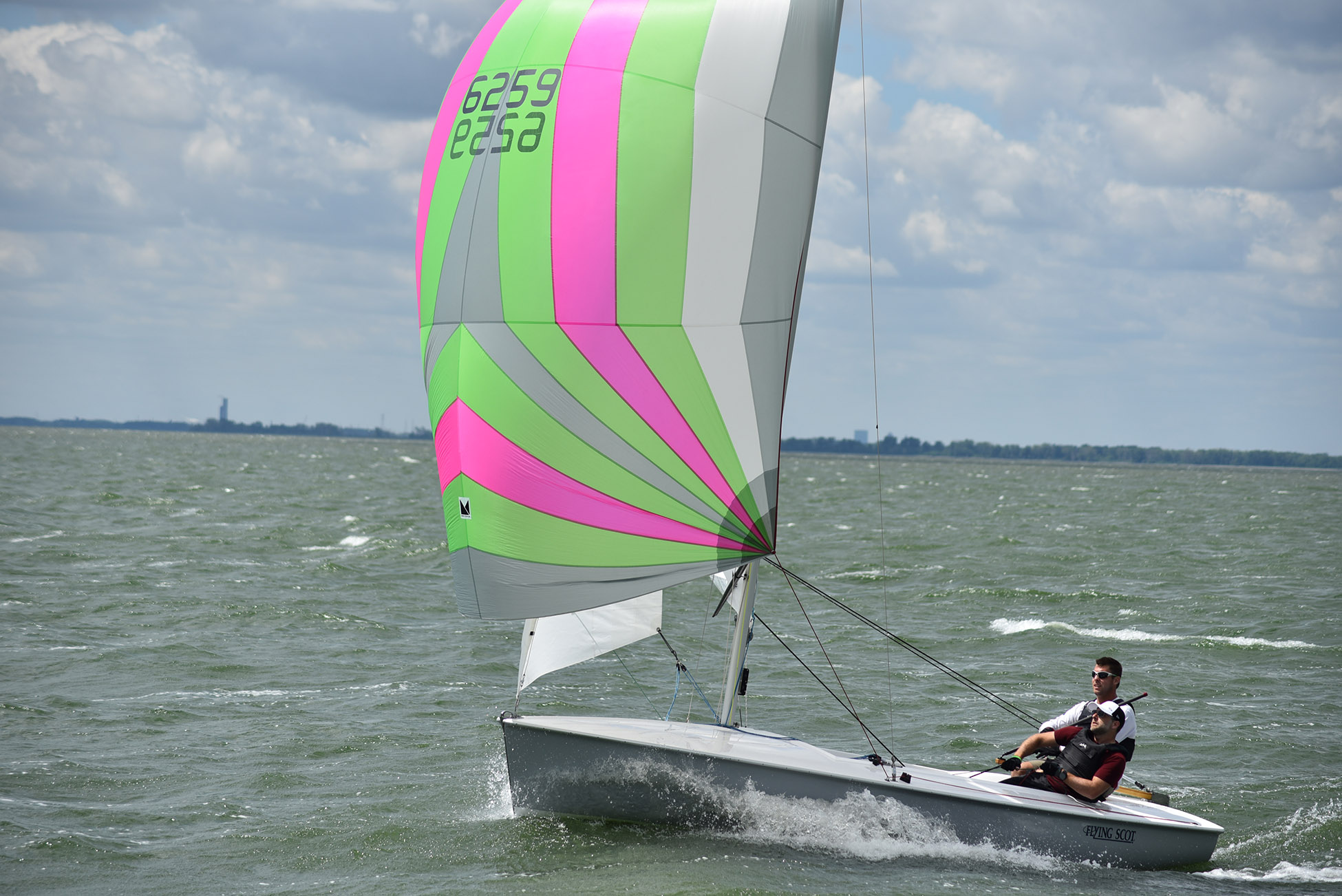Keeping the Ship Under the Sails
It’s been a windy summer full of capsize videos on Facebook and Youtube. I myself capsized this summer for the first time. Then I did it again. What’s funny is that the first time I capsized I had said earlier that morning that I will never capsize a Flying Scot. It was a ton of fun though, and I would not change a thing. From that capsize I learned how to better gybe in big breeze, which came in handy at Nationals. We did capsize at Nationals when I fell out of the boat upwind, but we came back to 5th so that does not count.
Here are some of my thoughts after my recent experiences:
Dare I say that staying upright upwind is easy, unless you fall out of the boat? Just ease the main until the boats settles down. If you want a speed technique here, ease the main as soon as the boat starts to load up and round up. Otherwise, she will round up, which she was designed to do. Gordon “Sandy” Douglass always said he wants his boat to be a “upper eater,” not only so that she points a bit better, but she’ll stop and wait on you should you fall out of the boat. It’s a lot faster if you ease the main, and let her keep driving, before she loads up and rounds up.
Downwind is the hard part…
Tip # 1: Mind the auto gybe. Us lake sailors know that if we’re sailing dead down, where the main could go on either side of the boat, then a wind shift could gybe us suddenly, catching our weight on the wrong side of the boat and sending us over. So broad reaching is much safer.
I have to go on a tangent here and tell the story of sailing with my buddy Kevin Schantz in his Thistle. We were on our way out to the race course when I started noticing holes from old hardware all over the boat’s seat tanks. When I mentioned them he responded “ Oh yea, we can’t capsize. We’ll sink quickly.” Once again, we were upside down within 15 minutes, thanks to an auto gybe with the chute up. Kevin was more concerned about the cooler of beer than the boat. Luckily, we managed to save both. It’s unbelievable how talking about not capsizing results in an immediate capsize. Perhaps that should be tip # 1. Don’t talk about capsizing.
Tip # 2: Trim the sails right! Broad reaching with the main and jib in a FS is a pretty safe place to sail, assuming that your equipment is in good enough shape to handle it. With good equipment the boat will certainly handle more wind then even the best of sailor’s will. Don’t go sailing in big conditions until you are confident that no matter where you’re sailing, you can keep your sails trimmed right proportionately to the wind angle. You can work on this with just the main up, with or without crew on board.
Working with the main alone is also a great time to hone your foot and hand work on the tacks. Allow me to quickly challenge you racers out there to try tacking while looking out over the water, rather than while looking down in the boat.
Tip # 3: Keep the Ship Under the Sails, and keep your weight back in the boat when you’re going fast. This is the big one. Skippers, it’s mostly in your hands (at least until the spinnaker goes up in Rule 4.) If exhilaration is not your thing, then you can quit reading now. If you’re reading on, then pull your centerboard up. Half way if you’re reaching, almost all the way if you’re sailing deeper down wind. It’s actually making the boat more stable, because there’s less drag on the helm, so you can “sail the boat under the sails” better. It’s also bringing the 80 pound of lead back in the boat, where you want your weight for planing. Words cannot do the skipping sensation justice, as you ease the main on a reach, drive down just a bit, and take off!

The whole pack takes off on a plane around the windward mark. Exhilerating!
Sailing a 2-sail reach in relatively windy conditions is as exhilarating as it gets. This is where you want to practice keeping the boat upright. On a reach, in enough wind to start healing the boat. What do you do? You are no longer on a point of sail where you can just ease your main. If you’re healing to leeward, which you will be on a reach, then drive the boat the way the mast is pointing. It will be “Down” away from the wind direction. In this instance, because you’re driving down, easing the main will still help. However, don’t let that confuse you because once you drive down enough, minding the gybe, then the boat might actually start healing back on top of you, threatening the dreaded “Death Roll.” Now what do you do? Again, drive the boat the way the mast is pointing. In that case it will be “up.” So, do we still want to ease out the main? Not this time! Easing the main drives the boat down away from the wind direction. We want to drive the boat up, to keep her under the sails, so we can trim in an arm length on the main. The most important thing though is the rudder. If you just steer the boat the way the mast is healing and mind the auto gybe, I’m not going to say it, but I’d be comfortable with your sailing ability at this point.
Tip # 4: Put knots in your spinnaker sheets I’m getting controversial now. Many sailors have been just letting go of the spinnaker sheets. That’s probably why you see so many crash videos of keel boats with the spinnaker stuck at the top of the mast blowing straight out, totally out of control. Here it is, are you listening? Before I sail in breeze with a new crew, I whisper into their ear. “If you’re uncomfortable when the chute is up, and you feel like the boat is going to capsize to weather, ie. Death roll, just strap her down like a piece of paper.” Namely trim, the sheet. It works so well! Before we capsized in the “Hand of God” video. We were going to capsize when that puff hit. I had pre discussed the SOP with my crew. I gave the order to strap it down. Typically the boat not only does not capsize, but she totally mellows out and slows down. That puff was so big, I’m guessing over 30, we did not mellow out. We got picked up by a force greater than I’ve ever felt in a sailboat and hurled downwind at 20 knots. Totally in control and totally stoked. Then we tried to gybe.
Tip # 5: Keep your weight back when you’re going fast, you can’t go forward to gybe. The mistake that we made that day was going forward to gybe like normal. We had similar wind conditions the second day at NACs this year. Only this time, when we went to gybe, nobody went forward. We just put the new guy in real quick. We left the old guy in also, and we left the pole on. We then threw the main over while planing. Remember that when you gybe, or sailing downwind in general, the faster you’re going, the less load there is on the boat. So, with our weight still in the back of the boat, we were able to gybe while never falling off of the plain. Once we gybed, we then trimmed the spinnaker behind the main to reduce the load on the boat. Only then did we slow down, with less sail area exposed to the wind, and my crew Jacob was able to go forward; remove the pole from the spinnaker, let it dangle, and bring his weight back again, while the spinnaker stayed full and we continued to haul downwind. Once the puff passed we then finished putting the pole back on.

Notice that the spinnaker pole is still not attached. No big deal!
So, knowing what I know now, I will dare to say it again, I will never again capsize a Flying Scot! (Pardon the arrogance.) She is a very stable boat, you can’t sink her and, it’s worth mentioning that you don’t need a towing bridle if you have a bow bag and inspection port, which all newer boats have. A power boat and a tow line certainly help though. That being said, if you take my advice here, then you won’t need those either.

No comments yet.